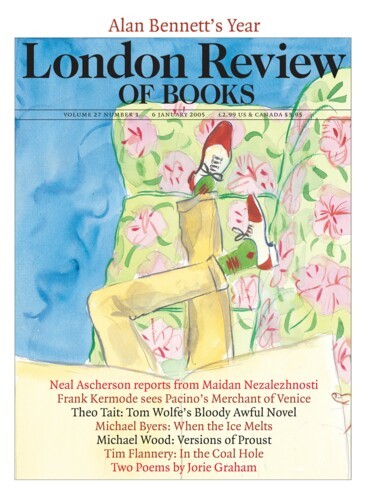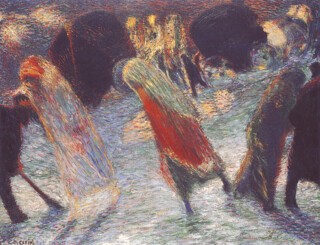Manet’s brisk little painting of a frieze of men in black opera hats and a few leggy girls in bright fancy dress, Masked Ball at the Opera (1873), kicks off Faces in the Crowd: Picturing Modern Life from Manet to Today, at the Whitechapel until 6 March. The last rooms in the exhibition show photographs, pictures, videos and projections made in the last couple of years – for example, Jeremy Deller’s film of 2001, The Battle of Orgreave. As you tread a more or less chronological path from Manet to the present you are pursued by ideas about the progress of art, and ideas about the commentary art gives on lives led in the city. Because it is ideas which link the artworks, and because the art comes from so many hands in so many styles, they tend to read as examples and illustrations even though many of them are very fine in themselves. The show is visually disjunctive but intellectually suggestive.
For example, both Walker Evans’s 1938-41 photographs of subway riders and Käthe Kollwitz’s Prisoners, an etching made thirty years earlier, have their place in an iconography of suppressed individuality. In both cases the faces seem to look inward – painfully (in the case of Kollwitz) or in stolid self-defence (in the case of Evans). Kollwitz insists that you feel; Evans presents faces which don’t offer the connections with a painterly tradition of facial expression that more formal or overtly poetic photographs would. Although less obviously so than most of the portraits he is famous for, Maika, Christian Schad’s Holbein-precise portrait of 1929, is a document of life in the bohemian interstices of the city. So are Nan Goldin’s colour photographs of friends in New York and Paris in the 1990s. Kollwitz and Schad interpret; they are telling us something, inviting us to feel. Evans and Goldin are showing us things but offering less information about how we could or should react. The juxtapositions are not particularly productive visually, but do make you think about what, at a point in time, artists have felt they were able, or not able, to do.
In an essay in the exhibition catalogue, Charles Harrison describes one kind of artistic inhibition with reference to Mark Rothko. In 1958 Rothko explained that although he belonged ‘to a generation that was preoccupied with the human figure’, and although it was something he studied, he found ‘with the utmost reluctance’ that it did not meet his needs. ‘Whoever used it mutilated it. No one could paint the figure as it was and feel that he could produce something that could express the world. I refuse to mutilate and had to find another way of expression.’ The way he found was to make abstract marks on canvas and abandon the look of the real world as a starting point. Faces in the Crowd attends to work by those who did not abandon, and would not abandon, the business of telling us how we are.
Not that figuration was the first thing to be jettisoned. ‘Who was it who said that drawing should be the transcription of form?’ Manet had already asked. ‘The truth is, art should be the transcription of life … You must translate what you feel, but your translation must be instantaneous … I would put it this way: everything that has a sense of humanity, a sense of modernity, is interesting; everything that lacks these is worthless.’ Think of the lushly rendered images which the Salon was then exhibiting and the state buying for public collections and you see, by looking at what he was fleeing, why he might have wanted to make art out of modern life.
In the earlier work in the show painters stared at the city at night, at its shadowy corners and its blurred, bright entertainments. The results were enlivening. Edvard Munch’s The Day After of 1895 would be a piece of moralising were it not for the way brush strokes seem to carve the girl sleeping off a hangover out of something thicker and more oppressive than air. While George Bellows’s 1924 picture of a boxing match is lively, populist documentary, Carlo Carrà’s Leaving the Theatre of 1909 already gives a radical account of appearance: feathery marks are woven into bright cocoons of colour which allow you to sustain for minutes an instant impression, a glance.
The photographers showed what the eye misses, and then found that their truths were as much an artefact as those of the painters. Here one has Weegee’s flash-lit New Yorkers, dead on the street or looking at others dead on the street. Is this the truth? Or is the truth to be found in the nuanced available light of René Burri, Cartier-Bresson and Robert Capa? ‘Truth’ not just in the sense of true to appearances. Are human beings like Weegee’s excited grinning bystanders? Or are they like Cartier-Bresson’s self-contained passers-by? They could of course be all these things, but maybe they are none of them.
In the rooms showing recent work, the flat and accidental, the snapshot or the passport photograph is the nearest point of reference. So although Atget’s photographs of Paris streets, monuments and shop windows were taken in the late 1800s and early 1900s – and are so bare of human content that a face seen through a window or a single distant figure produces a penetrating sense of loneliness – they make powerful connections with much later, self-conscious moves to take the maker out of the picture.
The smudged and twisted flesh of Bacon portraits, the bland picture-book pastel of Alex Katz’s Thursday Night #2 and Dubuffet’s child-like primitivism all show that the conception of painting as a growing body of knowledge, which goes deeper than style or subject, is a matter for history. In a way the moment when that game was over is the starting point of this exhibition. Manet’s radicalism, as the Manet/Velázquez exhibitions in Paris and New York in 2002-03 showed, did not prevent him sharing a profound, emulative admiration for 17th-century Spanish painting with those who had different ideas about the lives to be lived in art. A painter of modern life (Manet) and a painter of fashionable portraits (Sargent) used similar sources and methods. What made them different from each other was their engagement with the world around them. The kind of people they painted and the narratives their pictures imply, not different ideas about the practice of representation, are what set them apart. Later there were plenty of groups of artists who worked in common styles and issued manifestos. But no new addition to the art of translating what was seen into marks on canvas followed.
The final impression one gets is that there is still an intense desire to make art out of the urban condition. The politics of John Heartfield’s collages and the work of the Russians in the 1920s have not lost their verve and bite. But commercial imagery – still, moving, computer-made, photographed, even hand-drawn – has occupied so much of the visual universe that finding a margin to explore which has not already been inundated by that flood is hard going. One way is to subvert commercial output. The plainest example in the exhibition is Omer Fast’s CNN Concatenated (2002). You look at a television screen but the remote control seems to be in the hands of a hyperactive child: newsreader, correspondent, interviewer, interviewee follow each other in what at first seems like a meaningless jumble. Then you find that each fragment adds a word to a sentence which has nothing to do with the context in which it was originally spoken – what was public utterance becomes personal and intimate. But I can’t find that the meaning hidden within this carapace of screen-grabs and soundbites is, as the catalogue would have it, a ‘new form of subliminal narration’ within the televisual flow.
Faces in the Crowd* offers a wonderfully various and intelligently chosen spread of images. Think of it as a manifesto and you can almost believe that images will again show us how we are through how things look.
Send Letters To:
The Editor
London Review of Books,
28 Little Russell Street
London, WC1A 2HN
letters@lrb.co.uk
Please include name, address, and a telephone number.


